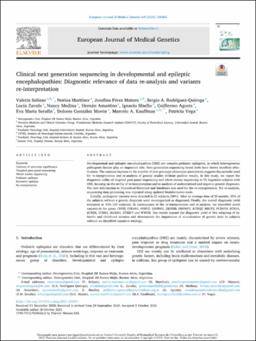| dc.description.abstract | Abstract
Developmental and epileptic encephalopathies (DEE) are complex pediatric epilepsies, in which heterogeneous pathogenic factors play an important role. Next-generation-sequencing based tools have shown excellent effectiveness. The constant increase in the number of new genotype-phenotype associations suggests the periodic need for re-interpretation and re-analysis of genetic studies without positive results. In this study, we report the diagnostic utility of targeted gene panel sequencing and whole exome sequencing in 55 Argentine subjects with DEE, focusing on the utility of re-interpretation and re-analysis of undetermined and negative genetic diagnoses. The new information in biomedical literature and databases was used for the re-interpretation. For re-analysis, sequencing data processing was repeated using updated bioinformatics tools. Initially, pathogenic variants were detected in 21 subjects (38%). After an average time of 29 months, 25% of the subjects without a genetic diagnosis were re-categorized as diagnosed. Finally, the overall diagnostic yield increased to 53% (29 subjects). In consequence of the re-interpretation and re-analysis, we identified novel variants in the genes: CHD2, COL4A1, FOXG1, GABRA1, GRIN2B, HNRNPU, KCNQ2, MECP2, PCDH19, SCN1A, SCN2A, SCN8A, SLC6A1, STXBP1 and WWOX. Our results expand the diagnostic yield of this subgroup of infantile and childhood seizures and demonstrate the importance of re-evaluation of genetic tests in subjects without an identified causative etiology.
Keywords: Pediatric epilepsy; Re-interpretation; Recessive epilepsy; Targeted gene panel sequencing; Variants of uncertain significance; Whole exome sequencing.
Published by Elsevier Masson SAS. | es |


